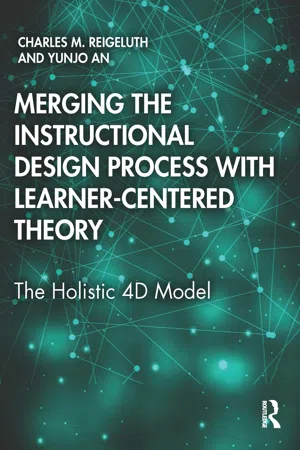
Merging the Instructional Design Process with Learner-Centered Theory
The Holistic 4D Model
- 226 pages
- English
- ePUB (mobile friendly)
- Available on iOS & Android
Merging the Instructional Design Process with Learner-Centered Theory
The Holistic 4D Model
About this book
Merging the Instructional Design Process with Learner-Centered Theory brings together the innovations of two previously divided processes — learning design strategies/theories and instructional systems development — into a new introductory textbook. Using a holistic rather than fragmented approach that includes top-level, mid-level, and lower-level design, this book provides guidance for major topics such as non-instructional interventions, just-in-time analysis, rapid-prototype approaches, and learner-centered, project-based, anytime-anywhere instruction. Informed by the authors' considerable experience and leadership throughout dramatic shifts in today's learning landscape, this book offers the next generation of instructional designers a fresh perspective that synthesizes and pushes beyond the basics of design and development.
Frequently asked questions
- Essential is ideal for learners and professionals who enjoy exploring a wide range of subjects. Access the Essential Library with 800,000+ trusted titles and best-sellers across business, personal growth, and the humanities. Includes unlimited reading time and Standard Read Aloud voice.
- Complete: Perfect for advanced learners and researchers needing full, unrestricted access. Unlock 1.4M+ books across hundreds of subjects, including academic and specialized titles. The Complete Plan also includes advanced features like Premium Read Aloud and Research Assistant.
Please note we cannot support devices running on iOS 13 and Android 7 or earlier. Learn more about using the app.
Information
1 Instructional Design
Overview
What Is Instructional Design?
The “Why and How” of ID
One heuristic used in solving problems with many possible solutions is to reduce the options by asking questions that may identify and eliminate inadequate or inappropriate solutions before beginning to investigate the remaining possibilities. Another heuristic often used by designers is to see if there is already a solution to a similar problem that can be adopted or adapted to the problem under analysis (with permission, as appropriate). |
The “When and Where” of ID
Context | Examples of ID Projects |
P-12 Education | Help teachers design technology-enhanced lessons Des... |
Table of contents
- Cover
- Half-Title
- Title
- Copyright
- Contents
- Preface
- Acknowledgments
- 1 Instructional Design
- UNIT 1 Define
- UNIT 2 Design
- 4 Other Considerations for Design
- 5 Top-Level Analysis, Design, and Evaluation
- 6 Mid-Level Analysis, Design, and Evaluation
- UNIT 3 Develop
- UNIT 4 Deploy
- Afterword
- Appendix
- Index